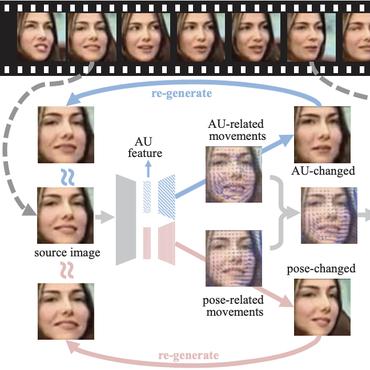Search Results for author: Zhiwen Shao
Found 18 papers, 9 papers with code
SimAda: A Simple Unified Framework for Adapting Segment Anything Model in Underperformed Scenes
1 code implementation • 31 Jan 2024 • Yiran Song, Qianyu Zhou, Xuequan Lu, Zhiwen Shao, Lizhuang Ma
In this paper, we aim to investigate the impact of the general vision modules on finetuning SAM and enable them to generalize across all downstream tasks.
CT-Net: Arbitrary-Shaped Text Detection via Contour Transformer
no code implementations • 25 Jul 2023 • Zhiwen Shao, Yuchen Su, Yong Zhou, Fanrong Meng, Hancheng Zhu, Bing Liu, Rui Yao
Contour based scene text detection methods have rapidly developed recently, but still suffer from inaccurate frontend contour initialization, multi-stage error accumulation, or deficient local information aggregation.
LRANet: Towards Accurate and Efficient Scene Text Detection with Low-Rank Approximation Network
1 code implementation • 27 Jun 2023 • Yuchen Su, Zhineng Chen, Zhiwen Shao, Yuning Du, Zhilong Ji, Jinfeng Bai, Yong Zhou, Yu-Gang Jiang
Next, we propose a dual assignment scheme for speed acceleration.
IterativePFN: True Iterative Point Cloud Filtering
1 code implementation • CVPR 2023 • Dasith de Silva Edirimuni, Xuequan Lu, Zhiwen Shao, Gang Li, Antonio Robles-Kelly, Ying He
Consequently, a fundamental 3D vision task is the removal of noise, known as point cloud filtering or denoising.
TextDCT: Arbitrary-Shaped Text Detection via Discrete Cosine Transform Mask
no code implementations • 27 Jun 2022 • Yuchen Su, Zhiwen Shao, Yong Zhou, Fanrong Meng, Hancheng Zhu, Bing Liu, Rui Yao
Arbitrary-shaped scene text detection is a challenging task due to the variety of text changes in font, size, color, and orientation.
Show, Deconfound and Tell: Image Captioning With Causal Inference
1 code implementation • CVPR 2022 • Bing Liu, Dong Wang, Xu Yang, Yong Zhou, Rui Yao, Zhiwen Shao, Jiaqi Zhao
In the encoding stage, the IOD is able to disentangle the region-based visual features by deconfounding the visual confounder.
"Forget" the Forget Gate: Estimating Anomalies in Videos using Self-contained Long Short-Term Memory Networks
no code implementations • 3 Apr 2021 • Habtamu Fanta, Zhiwen Shao, Lizhuang Ma
Abnormal event detection is a challenging task that requires effectively handling intricate features of appearance and motion.
Fine-Grained Expression Manipulation via Structured Latent Space
1 code implementation • 21 Apr 2020 • Junshu Tang, Zhiwen Shao, Lizhuang Ma
Most existing expression manipulation methods resort to discrete expression labels, which mainly edit global expressions and ignore the manipulation of fine details.
SiTGRU: Single-Tunnelled Gated Recurrent Unit for Abnormality Detection
no code implementations • 30 Mar 2020 • Habtamu Fanta, Zhiwen Shao, Lizhuang Ma
In this paper, we propose a novel version of Gated Recurrent Unit (GRU), called Single Tunnelled GRU for abnormality detection.
J$\hat{\text{A}}$A-Net: Joint Facial Action Unit Detection and Face Alignment via Adaptive Attention
1 code implementation • 18 Mar 2020 • Zhiwen Shao, Zhilei Liu, Jianfei Cai, Lizhuang Ma
Moreover, to extract precise local features, we propose an adaptive attention learning module to refine the attention map of each AU adaptively.
GeoConv: Geodesic Guided Convolution for Facial Action Unit Recognition
no code implementations • 6 Mar 2020 • Yuedong Chen, Guoxian Song, Zhiwen Shao, Jianfei Cai, Tat-Jen Cham, Jianming Zheng
Automatic facial action unit (AU) recognition has attracted great attention but still remains a challenging task, as subtle changes of local facial muscles are difficult to thoroughly capture.
Facial Action Unit Detection via Adaptive Attention and Relation
no code implementations • 5 Jan 2020 • Zhiwen Shao, Yong Zhou, Jianfei Cai, Hancheng Zhu, Rui Yao
Specifically, we propose an adaptive attention regression network to regress the global attention map of each AU under the constraint of attention predefinition and the guidance of AU detection, which is beneficial for capturing both specified dependencies by landmarks in strongly correlated regions and facial globally distributed dependencies in weakly correlated regions.
Explicit Facial Expression Transfer via Fine-Grained Representations
no code implementations • 6 Sep 2019 • Zhiwen Shao, Hengliang Zhu, Junshu Tang, Xuequan Lu, Lizhuang Ma
Instead of using an intermediate estimated guidance, we propose to explicitly transfer facial expression by directly mapping two unpaired input images to two synthesized images with swapped expressions.
Unconstrained Facial Action Unit Detection via Latent Feature Domain
1 code implementation • 25 Mar 2019 • Zhiwen Shao, Jianfei Cai, Tat-Jen Cham, Xuequan Lu, Lizhuang Ma
Due to the combination of source AU-related information and target AU-free information, the latent feature domain with transferred source label can be learned by maximizing the target-domain AU detection performance.
Facial Action Unit Detection Using Attention and Relation Learning
no code implementations • 10 Aug 2018 • Zhiwen Shao, Zhilei Liu, Jianfei Cai, Yunsheng Wu, Lizhuang Ma
By finding the region of interest of each AU with the attention mechanism, AU-related local features can be captured.
Deep Multi-Center Learning for Face Alignment
1 code implementation • 5 Aug 2018 • Zhiwen Shao, Hengliang Zhu, Xin Tan, Yangyang Hao, Lizhuang Ma
Most of the existing deep learning methods only use one fully-connected layer called shape prediction layer to estimate the locations of facial landmarks.
 Ranked #3 on
Face Alignment
on AFLW2000
Ranked #3 on
Face Alignment
on AFLW2000
Deep Adaptive Attention for Joint Facial Action Unit Detection and Face Alignment
1 code implementation • ECCV 2018 • Zhiwen Shao, Zhilei Liu, Jianfei Cai, Lizhuang Ma
Facial action unit (AU) detection and face alignment are two highly correlated tasks since facial landmarks can provide precise AU locations to facilitate the extraction of meaningful local features for AU detection.
 Ranked #5 on
Facial Action Unit Detection
on DISFA
Ranked #5 on
Facial Action Unit Detection
on DISFA
Learning deep representation from coarse to fine for face alignment
no code implementations • 31 Jul 2016 • Zhiwen Shao, Shouhong Ding, Yiru Zhao, Qinchuan Zhang, Lizhuang Ma
In this paper, we propose a novel face alignment method that trains deep convolutional network from coarse to fine.








